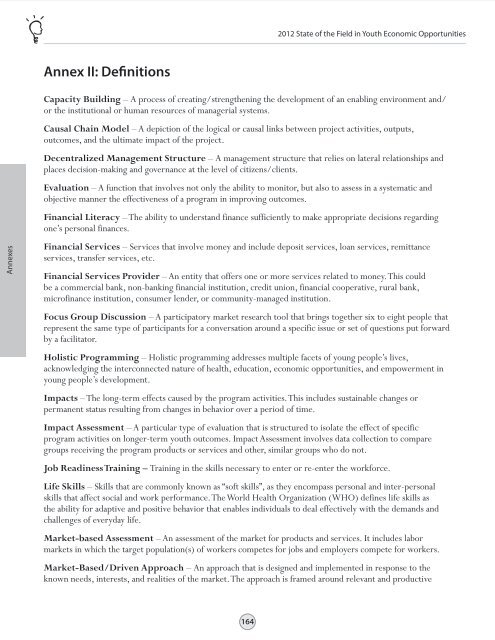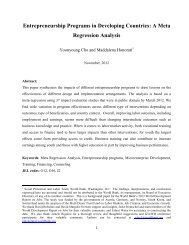STATE OF THE FIELD IN YOUTH ECONOMIC OPPORTUNITIES
STATE OF THE FIELD IN YOUTH ECONOMIC OPPORTUNITIES
STATE OF THE FIELD IN YOUTH ECONOMIC OPPORTUNITIES
You also want an ePaper? Increase the reach of your titles
YUMPU automatically turns print PDFs into web optimized ePapers that Google loves.
Table of Contents<br />
Chapter 1 Chapter 2 Chapter 3 Chapter 4 Chapter 5 Chapter 6 Chapter 7 Chapter 8<br />
Chapter 9<br />
Chapter 10 Chapter 11 Chapter 12 Chapter 13 Chapter 14 Chapter 15 Annexes<br />
2012 State of the Field in Youth Economic Opportunities<br />
Annex II: Definitions<br />
Capacity Building – A process of creating/strengthening the development of an enabling environment and/<br />
or the institutional or human resources of managerial systems.<br />
Causal Chain Model – A depiction of the logical or causal links between project activities, outputs,<br />
outcomes, and the ultimate impact of the project.<br />
Decentralized Management Structure – A management structure that relies on lateral relationships and<br />
places decision-making and governance at the level of citizens/clients.<br />
Evaluation – A function that involves not only the ability to monitor, but also to assess in a systematic and<br />
objective manner the effectiveness of a program in improving outcomes.<br />
Financial Literacy – The ability to understand finance sufficiently to make appropriate decisions regarding<br />
one’s personal finances.<br />
Annexes<br />
Financial Services – Services that involve money and include deposit services, loan services, remittance<br />
services, transfer services, etc.<br />
Financial Services Provider – An entity that offers one or more services related to money. This could<br />
be a commercial bank, non-banking financial institution, credit union, financial cooperative, rural bank,<br />
microfinance institution, consumer lender, or community-managed institution.<br />
Focus Group Discussion – A participatory market research tool that brings together six to eight people that<br />
represent the same type of participants for a conversation around a specific issue or set of questions put forward<br />
by a facilitator.<br />
Holistic Programming – Holistic programming addresses multiple facets of young people’s lives,<br />
acknowledging the interconnected nature of health, education, economic opportunities, and empowerment in<br />
young people’s development.<br />
Impacts – The long-term effects caused by the program activities. This includes sustainable changes or<br />
permanent status resulting from changes in behavior over a period of time.<br />
Impact Assessment – A particular type of evaluation that is structured to isolate the effect of specific<br />
program activities on longer-term youth outcomes. Impact Assessment involves data collection to compare<br />
groups receiving the program products or services and other, similar groups who do not.<br />
Job Readiness Training – Training in the skills necessary to enter or re-enter the workforce.<br />
Life Skills – Skills that are commonly known as “soft skills”, as they encompass personal and inter-personal<br />
skills that affect social and work performance. The World Health Organization (WHO) defines life skills as<br />
the ability for adaptive and positive behavior that enables individuals to deal effectively with the demands and<br />
challenges of everyday life.<br />
Market-based Assessment – An assessment of the market for products and services. It includes labor<br />
markets in which the target population(s) of workers competes for jobs and employers compete for workers.<br />
Market-Based/Driven Approach – An approach that is designed and implemented in response to the<br />
known needs, interests, and realities of the market. The approach is framed around relevant and productive<br />
164

















